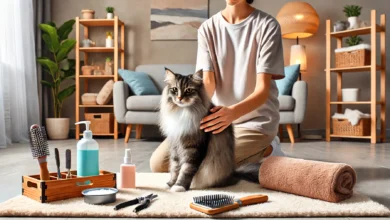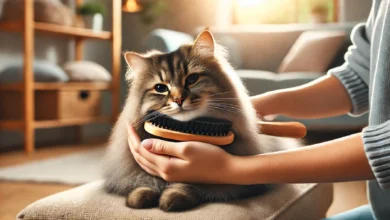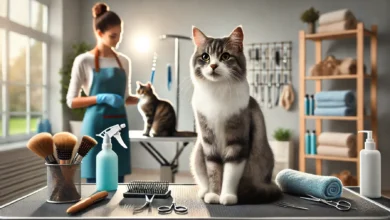Addressing Cat Allergies with Safe Grooming Products
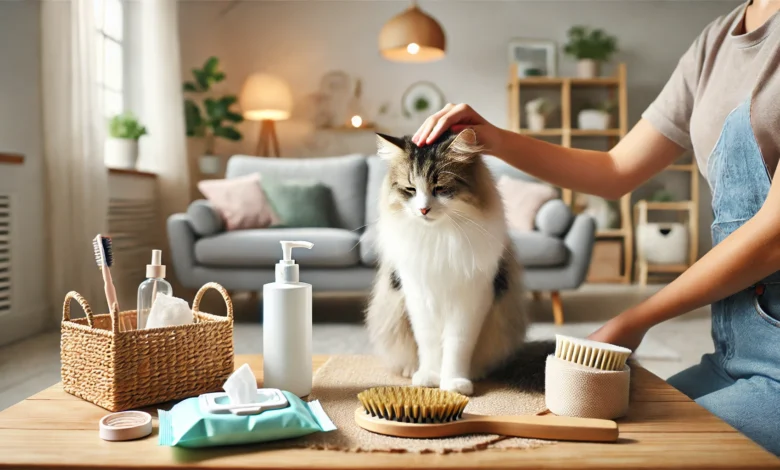
Cat allergies pose a day-to-day concern for every feline owner and the cats themselves.
While it may seem like allergies should only affect humans, many domestic cats develop allergic reactions that can make them feel miserable and lead to serious health problems.
In most cases, the management of these cat allergies among owners begins with grooming practices.
Using the right grooming products will make all the difference, not just for your cat’s health but also in reducing allergic reactions for people who share their homes with cats.
In this article, we will look at how you can manage or handle cat allergies by using non-allergenic grooming products and techniques.
Table of Contents
Understanding Cat Allergies and Their Symptoms
The development of a cat allergy can be triggered by many factors, ranging from environmental allergens to particular ingredients in grooming products.
Both for cats and their owners, it is very important to learn the most common causes of these cat allergies to build a healthy environment.
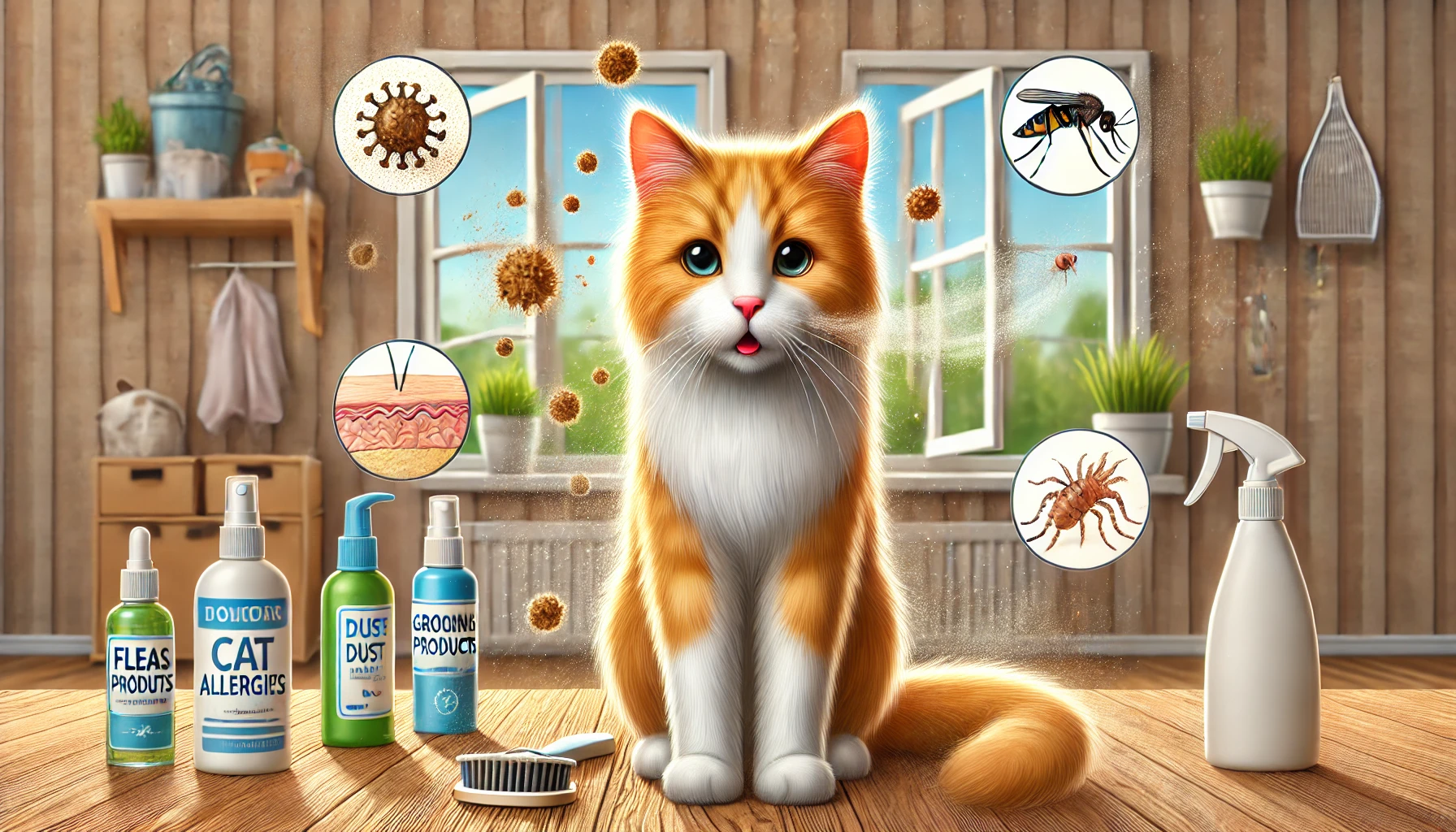
Common Causes of Cat Allergies
Just like people, cats can develop allergic reactions to various things.
Some of the more common culprits include:
- Dust and pollen from the environment
- Ingredients in grooming products, such as perfumes or chemicals
- Fleas and flea bites
- Food allergies, particularly from grains or certain proteins
These allergens can cause your cat to itch, scratch, or even show signs of skin redness, hair loss, or respiratory problems.
If left untreated, they may result in serious health complications over time.
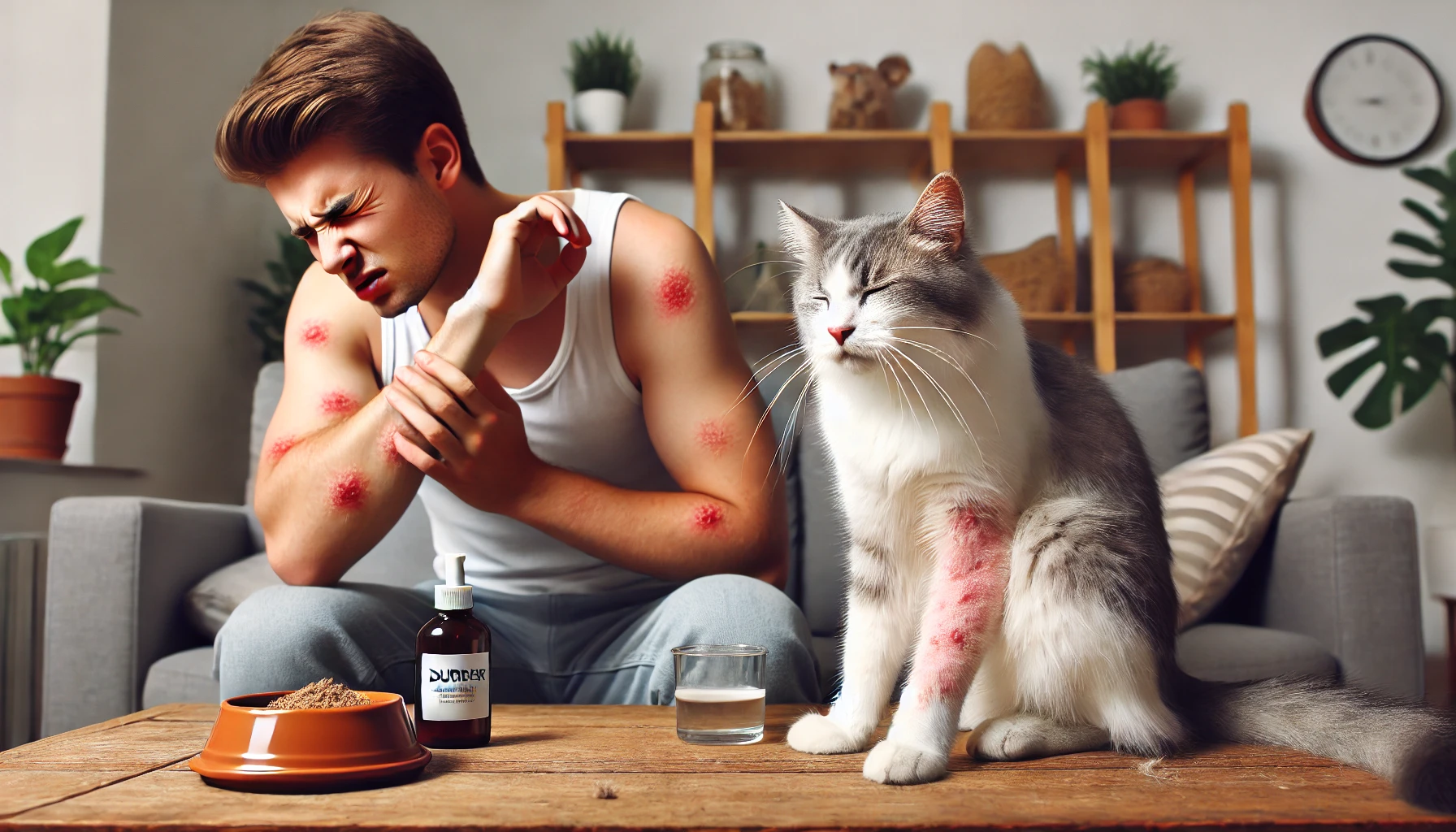
Recognizing Symptoms in Cats and Owners
Both cats and owners can exhibit allergic reactions, and knowing the symptoms is the first important step in addressing the issue.
Common signs of allergies in cats include:
- Itchy skin or extreme scratching
- Frequent sneezing or coughing
- Watery eyes or runny nose
- Patchy fur or hair loss
- Red, irritated skin
In owners who are allergic to cats, some symptoms include sneezing, itchy eyes, and skin irritation after contact with cat dander or fur.
Once any of these signs become apparent, it is essential to switch to grooming products that are free from harsh chemicals and allergens to minimize cat allergies.
Understanding the causes and symptoms of cat allergies is key to managing your pet’s health and reducing reactions in your household.
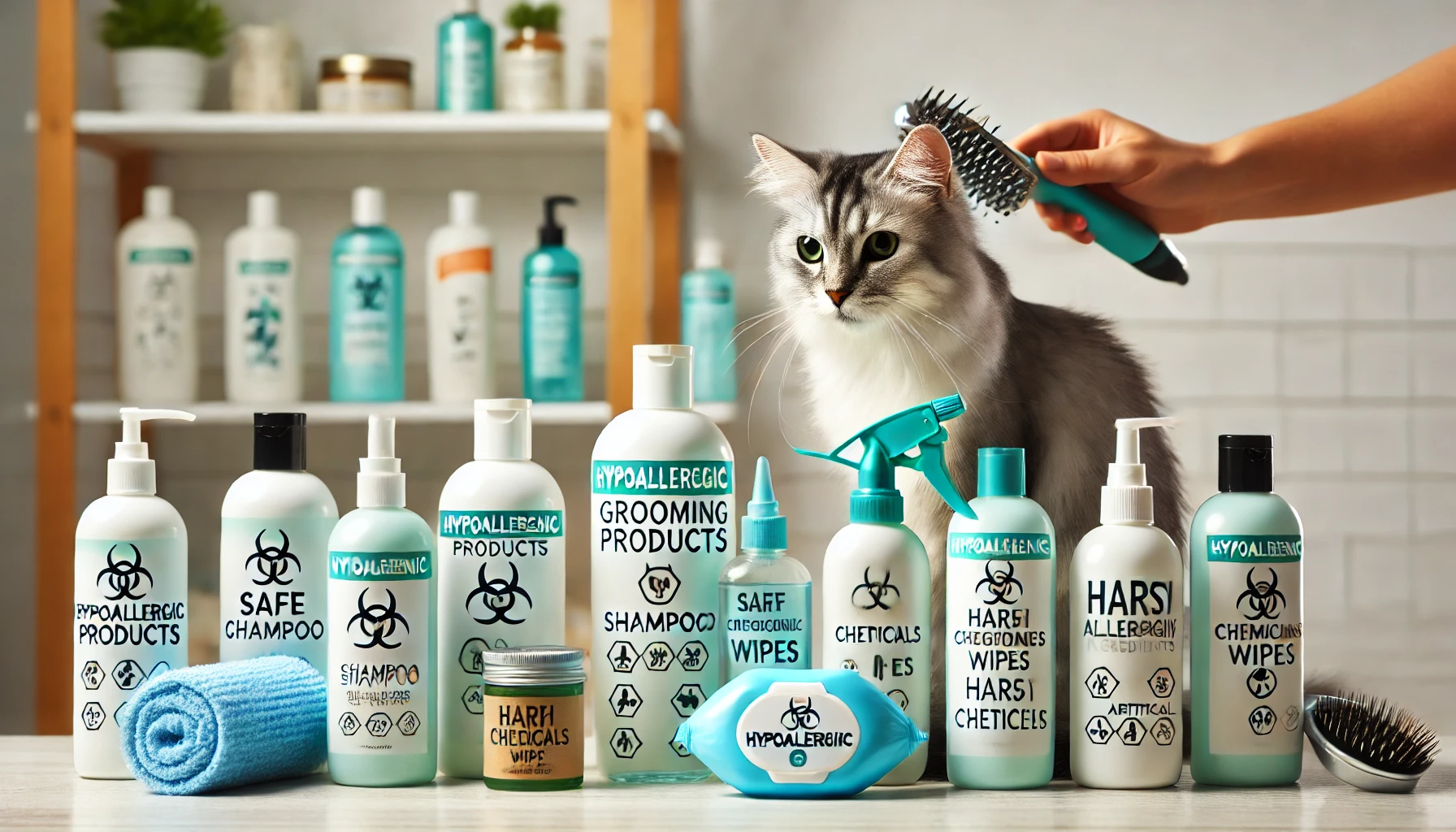
How Grooming Products Can Trigger or Reduce Cat Allergies
Grooming products can exacerbate or alleviate cat allergies in both cats and their owners alike due to their important function.
The best way to make informed choices that will enhance your cat’s health while minimizing allergic reactions is by understanding the various ingredients found in grooming products that are either harmful or helpful.
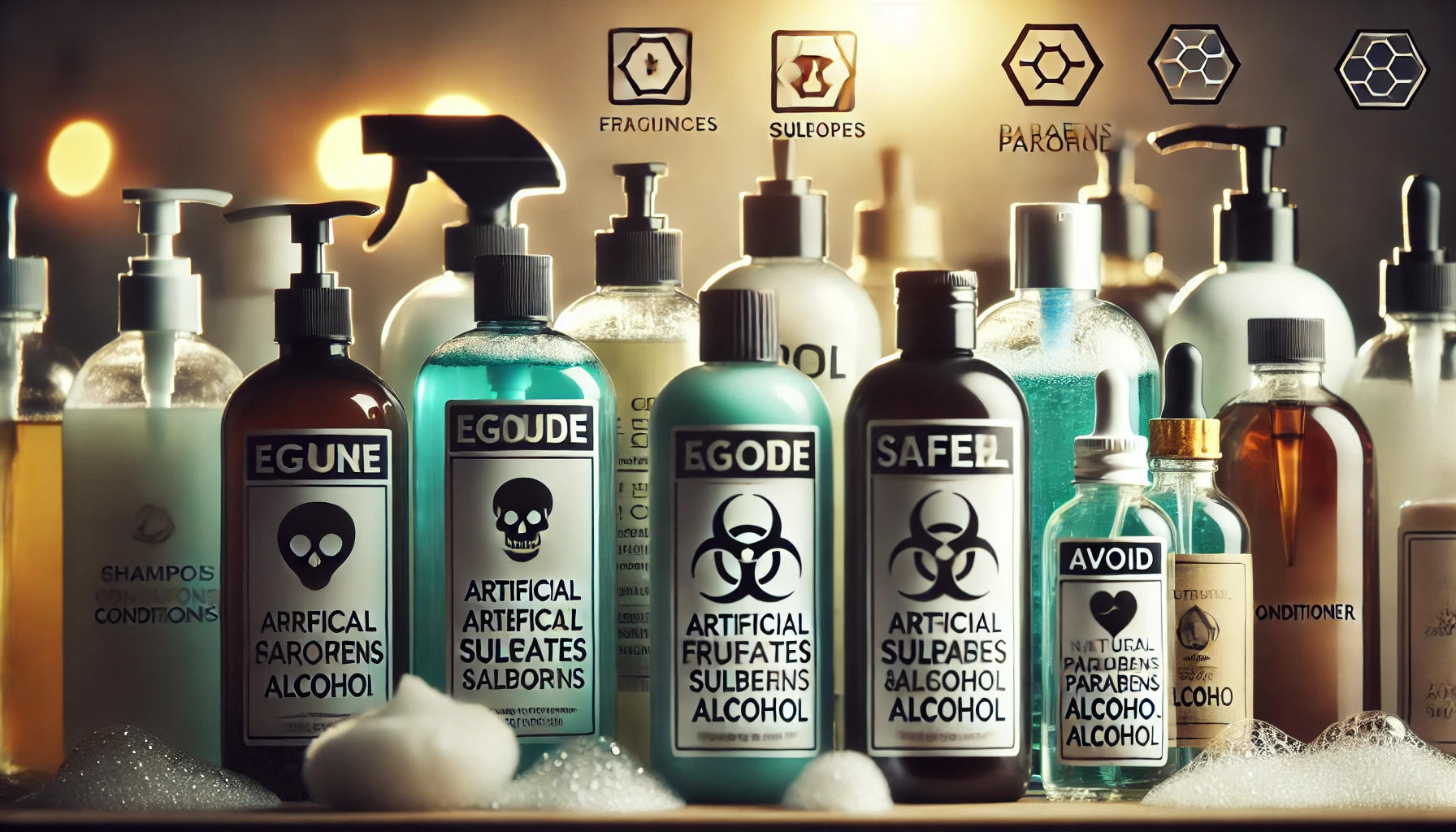
Ingredients to Avoid in Grooming Products
Many commercial grooming products contain chemicals and fragrances that can irritate allergies in cats.
Not only do these ingredients harm cats, but they may also be detrimental to cat owners, especially if they have sensitive constitutions.
Some common ingredients to avoid include:
- Artificial fragrances: These are among the major causes of irritation in both cats and their owners. The use of harsh artificial fragrances can cause problems on your cat’s sensitive skin and may lead to respiratory effects.
- Sulfates: Found in many shampoos, sulfates are tough cleaning agents that strip the skin of natural oils, leading to dryness and irritation.
- Parabens: Preservative chemicals like parabens can disrupt hormonal balance in both humans and pets, triggering allergic reactions when used over time.
- Alcohol: Alcohol-based products can dry out the skin, increasing the likelihood of irritation and allergic flare-ups.
Avoiding these ingredients will help maintain feline skin health and reduce the chances of cat allergies in both cats and their owners.

Cat Allergy-Friendly Ingredients
Fortunately, there are safe alternatives when it comes to grooming products for cats with allergies.
Hypoallergenic and natural ingredients can soothe sensitive skin and limit allergic reactions.
Some recommended allergy-friendly ingredients include:
- Aloe vera: A soothing ingredient, aloe vera calms irritated skin and helps with moisture retention.
- Oatmeal: A natural anti-inflammatory, oatmeal is commonly used in cat shampoos to combat itching and dry skin.
- Coconut oil: Skin-friendly and anti-inflammatory, coconut oil is ideal for cats with sensitive skin.
- Chamomile: Chamomile extract can help reduce skin redness and irritation, offering a calming effect for allergic cats.
Grooming products containing these natural, gentle ingredients will help reduce cat allergies while promoting healthier skin and a shinier coat.
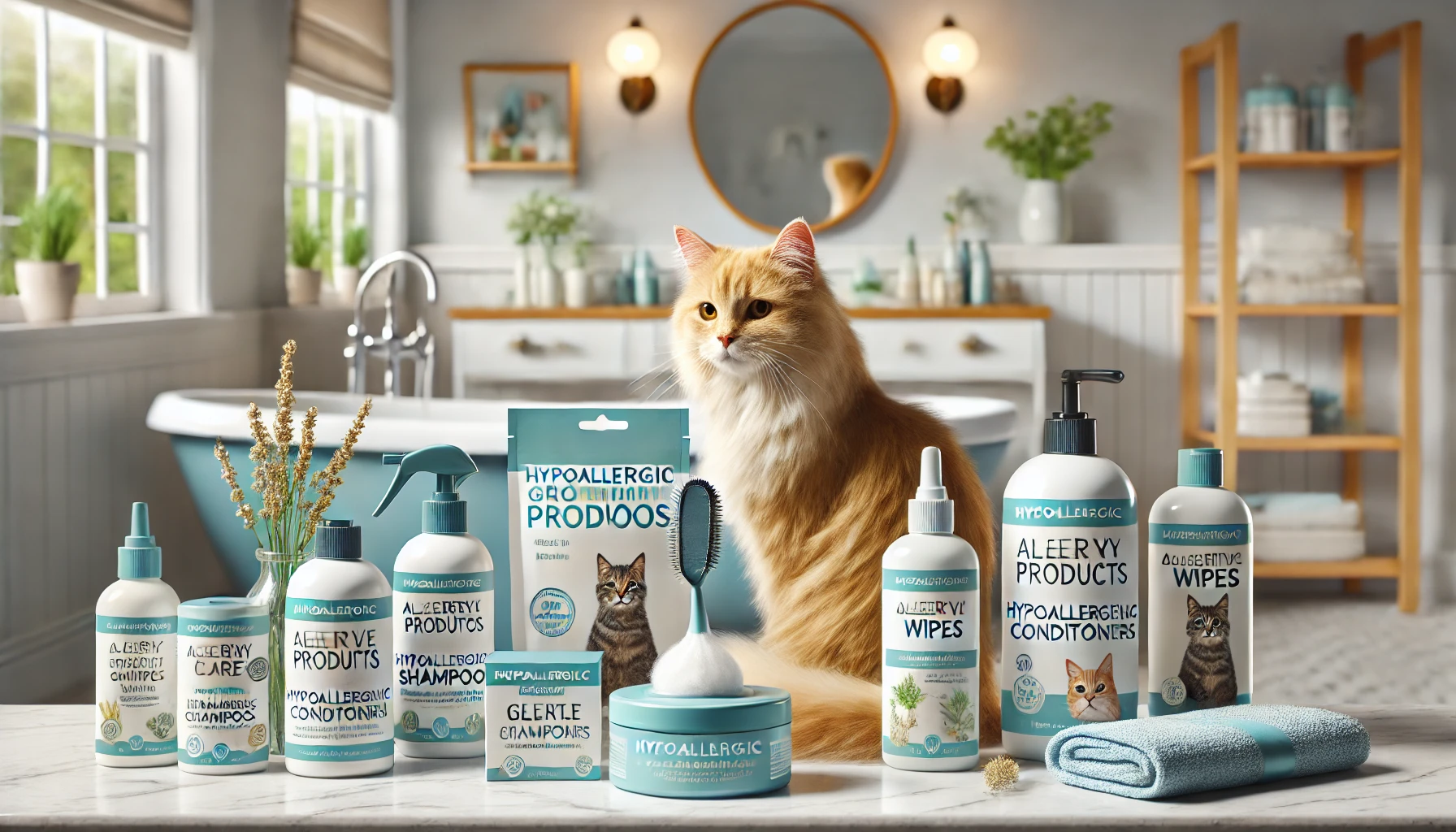
Picking the Right Grooming Products for Allergy-Prone Cats
Picking the right grooming products for a cat with allergies is extremely important to keep your cat healthy and comfortable.
Not all grooming products are alike, and many contain ingredients that can set off cat allergies.
When picking out grooming products, it’s best to focus on hypoallergenic and natural formulations that will not further irritate your cat’s skin or coat.
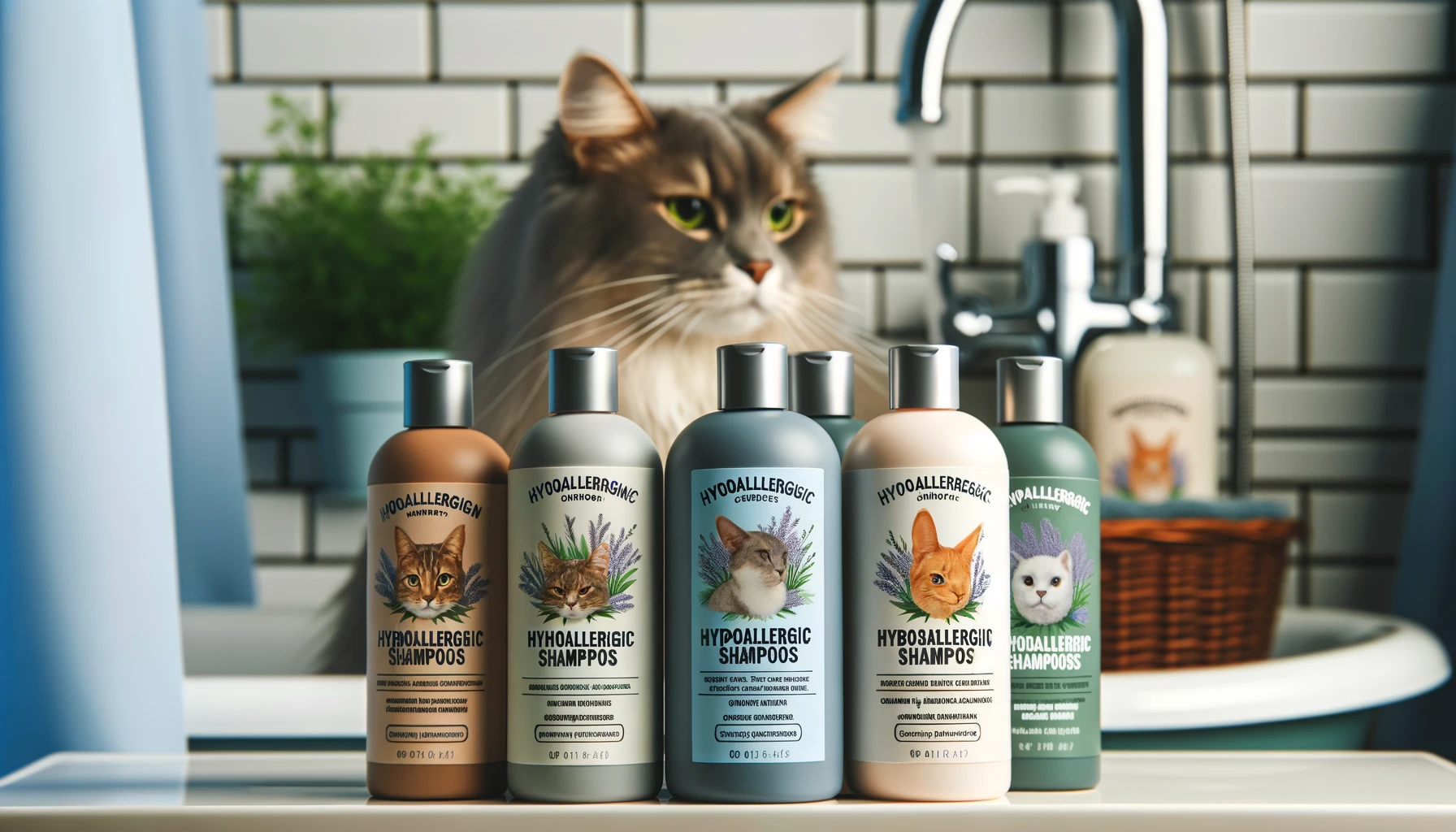
Hypoallergenic Shampoos and Conditioners
Hypoallergenic shampoos and conditioners are specifically created to minimize the risk of allergic reactions.
Many such products avoid harsh chemicals, artificial fragrances, and dyes, which can irritate a cat’s sensitive skin.
They incorporate soothing ingredients like aloe vera, oatmeal, and coconut oil, which provide great moisturizing and protection for the skin.
When choosing a hypoallergenic shampoo, go for those that state they are sulfate-, paraben-, and alcohol-free on their labels.
- Aloe vera-based shampoos: Ideal for calming irritated skin and reducing inflammation.
- Oatmeal shampoos: Soothe dry, itchy skin and can help alleviate cat allergies.
- Coconut oil shampoos: Hydrating in nature, these shampoos reduce irritation and help maintain healthy skin.
These shampoos can help reduce allergens such as dander, which is a common cause of cat allergies in humans.
Always rinse thoroughly, leaving no residue behind, as any leftover product can irritate sensitive skin further.
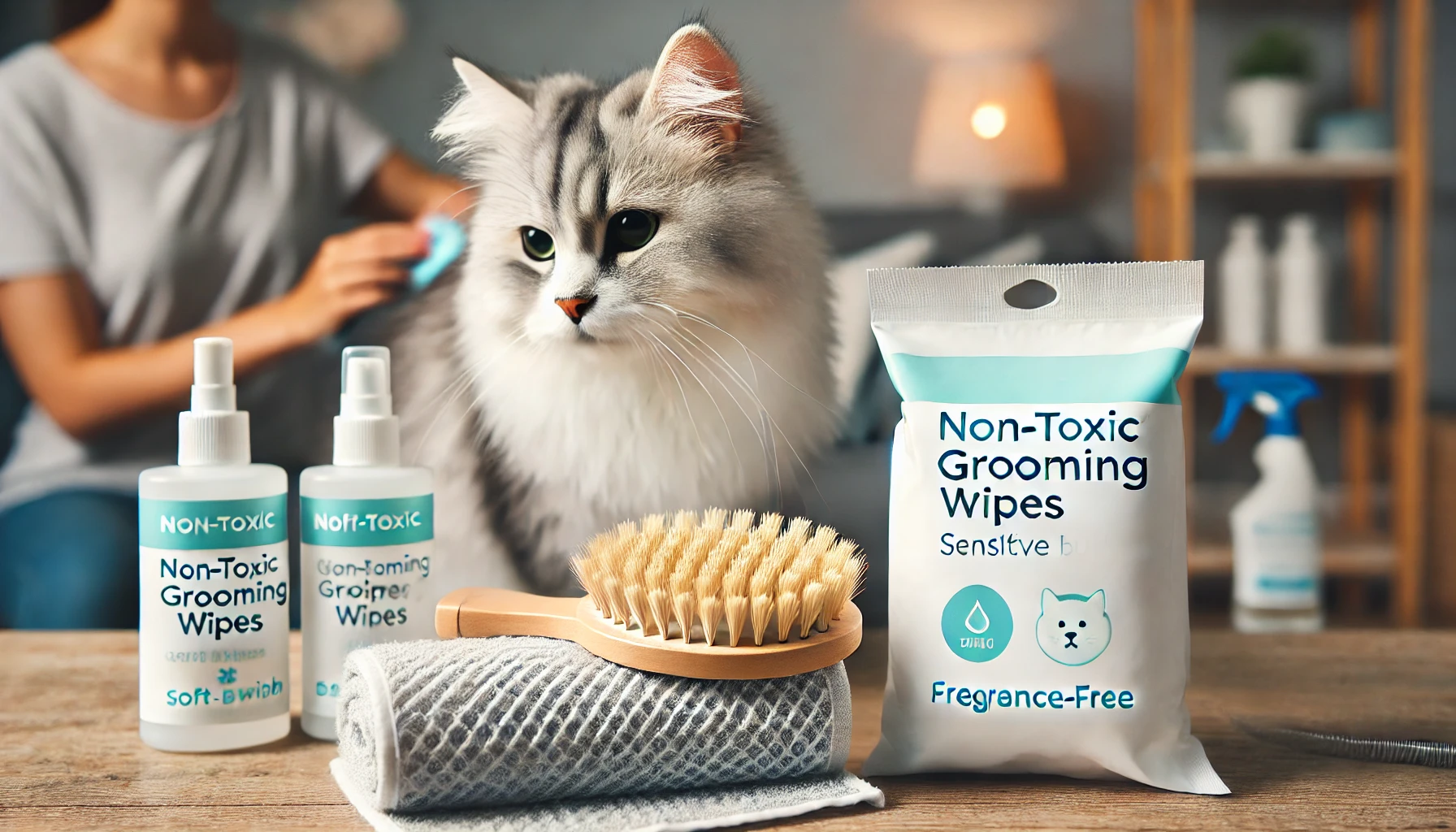
Non-Toxic Wipes and Brushes for Sensitive Cats
Apart from shampoos, non-toxic grooming wipes and gentle brushes are an excellent combination to maintain your cat’s hygiene without causing allergic reactions.
Grooming wipes, especially those free from artificial fragrances and harsh chemicals, are an effective way to clean your cat between baths.
They help reduce the amount of dander and allergens on your cat’s coat.
- Fragrance-free wipes: These are perfect for cleaning your cat’s fur without aggravating their skin or causing allergies.
- Natural grooming wipes: Contain gentle ingredients such as chamomile and aloe, which are great for soothing sensitive skin.
- Gentle brushes: Soft-bristled brushes that won’t hurt, bruise, or irritate your cat’s sensitive skin.
Regular brushing helps significantly reduce allergens.
It removes loose fur and dander, which can trigger allergic reactions.
For cats with sensitive skin, make sure to choose brushes specifically designed for them to avoid further irritation.
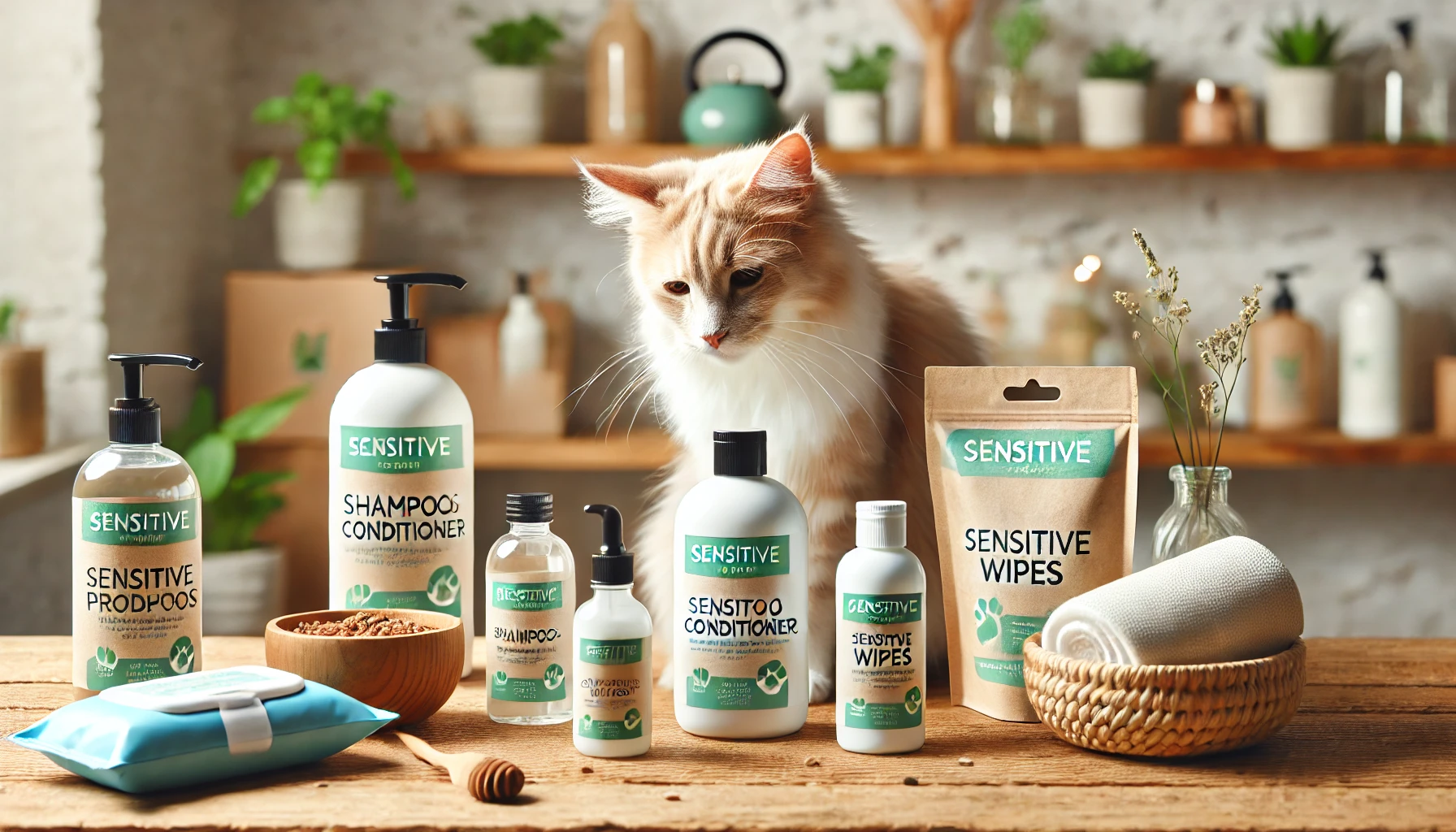
Eco-Friendly Products for Sensitive Skin
Eco-friendly grooming products are a great option for both cats and the environment.
They often use biodegradable ingredients and avoid harmful chemicals that could lead to cat allergies.
Look for labels that indicate the product is non-toxic, biodegradable, and sustainably sourced.
Using eco-friendly products means you are not only protecting your cat from harmful chemicals but also reducing environmental pollution.
Most eco-friendly products are plant-based, making them gentle on your cat’s skin and safe for frequent use.
By using eco-friendly grooming products, you are contributing to both your cat’s health and the well-being of the planet.
Selecting hypoallergenic shampoos and natural grooming products is crucial for maintaining your cat’s health and minimizing allergic reactions in sensitive pets.
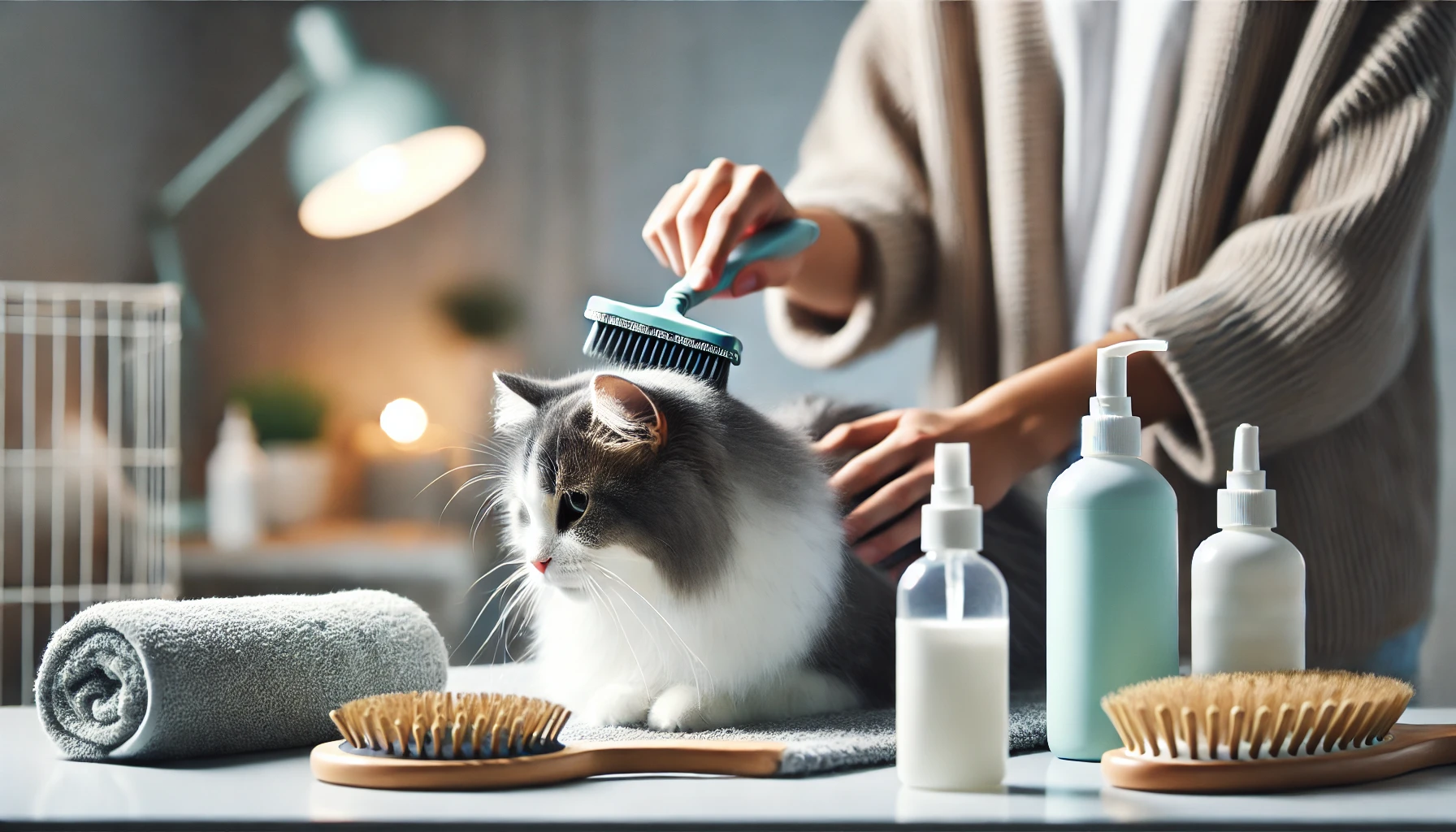
Grooming Your Cat Safely: How to Minimize Cat Allergies
Proper grooming of your cat is one of the most important ways of handling cat allergies for both cats and their human companions.
Regular grooming keeps your cat neat and minimizes allergens, such as dander, which may cause allergic reactions.
It is critical to use proper techniques for safety and effectiveness in minimizing allergens.
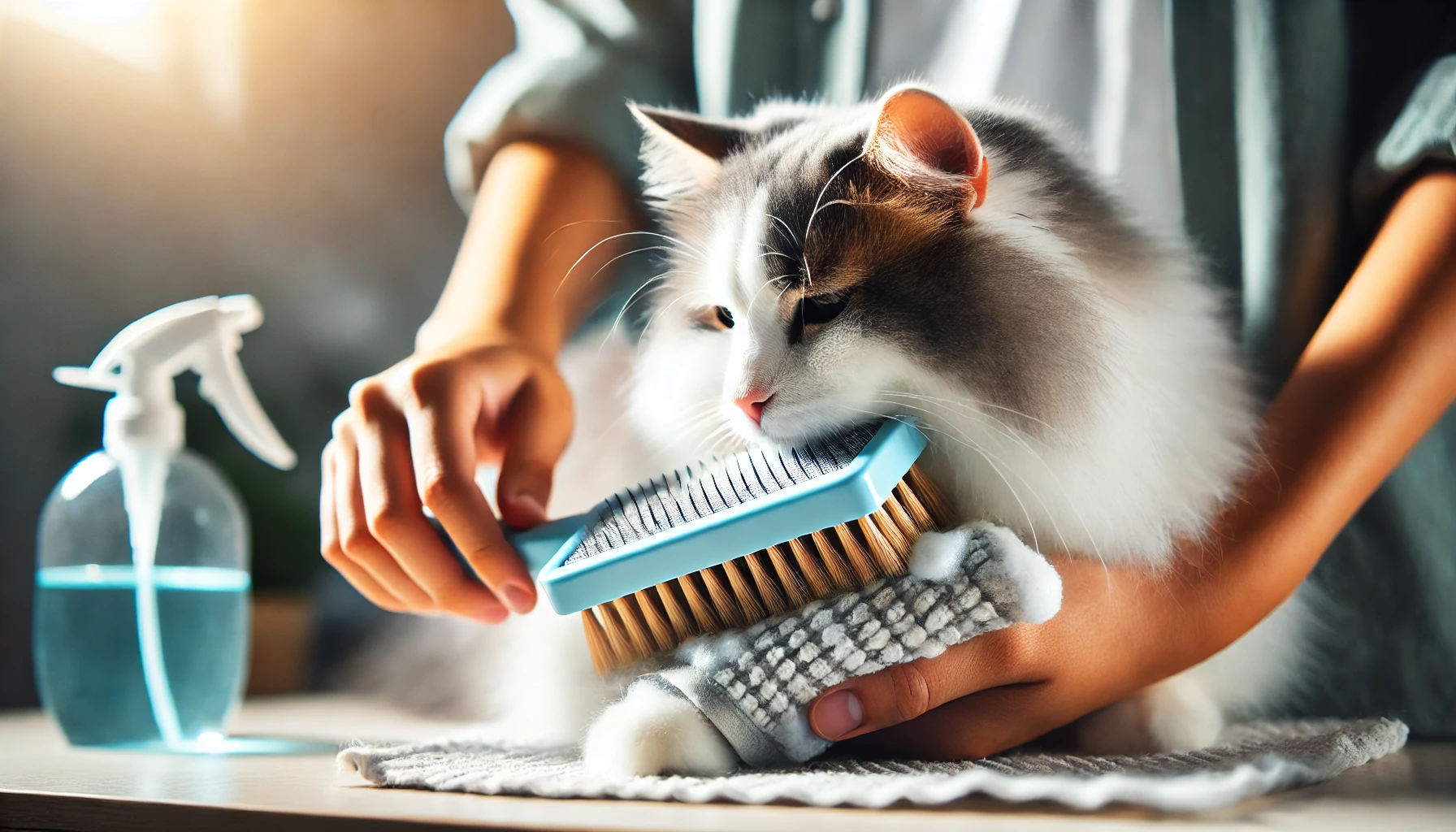
Grooming Techniques to Reduce Dander
Dander, the tiny particles of dead skin shed by cats, is one of the main causes of cat allergies in humans.
Grooming techniques that reduce dander can greatly help minimize allergic reactions.
Some effective methods include:
- Regular brushing: Gently brush your cat at least 2 to 3 times a week with a soft-bristle brush. This helps remove loose fur and dander so it doesn’t accumulate on your cat’s skin.
- Using a damp cloth: After brushing, use a slightly dampened cloth to pick up any remaining dander and loose fur. This also helps trap allergens before they become airborne.
- Bathing: Regular bathing, once a month, with a hypoallergenic cat shampoo reduces the amount of dander your cat sheds. Always rinse the shampoo thoroughly to avoid leaving any residue.
These simple practices help minimize dander while keeping your cat’s coat and skin healthier, which in turn reduces allergens in your home.
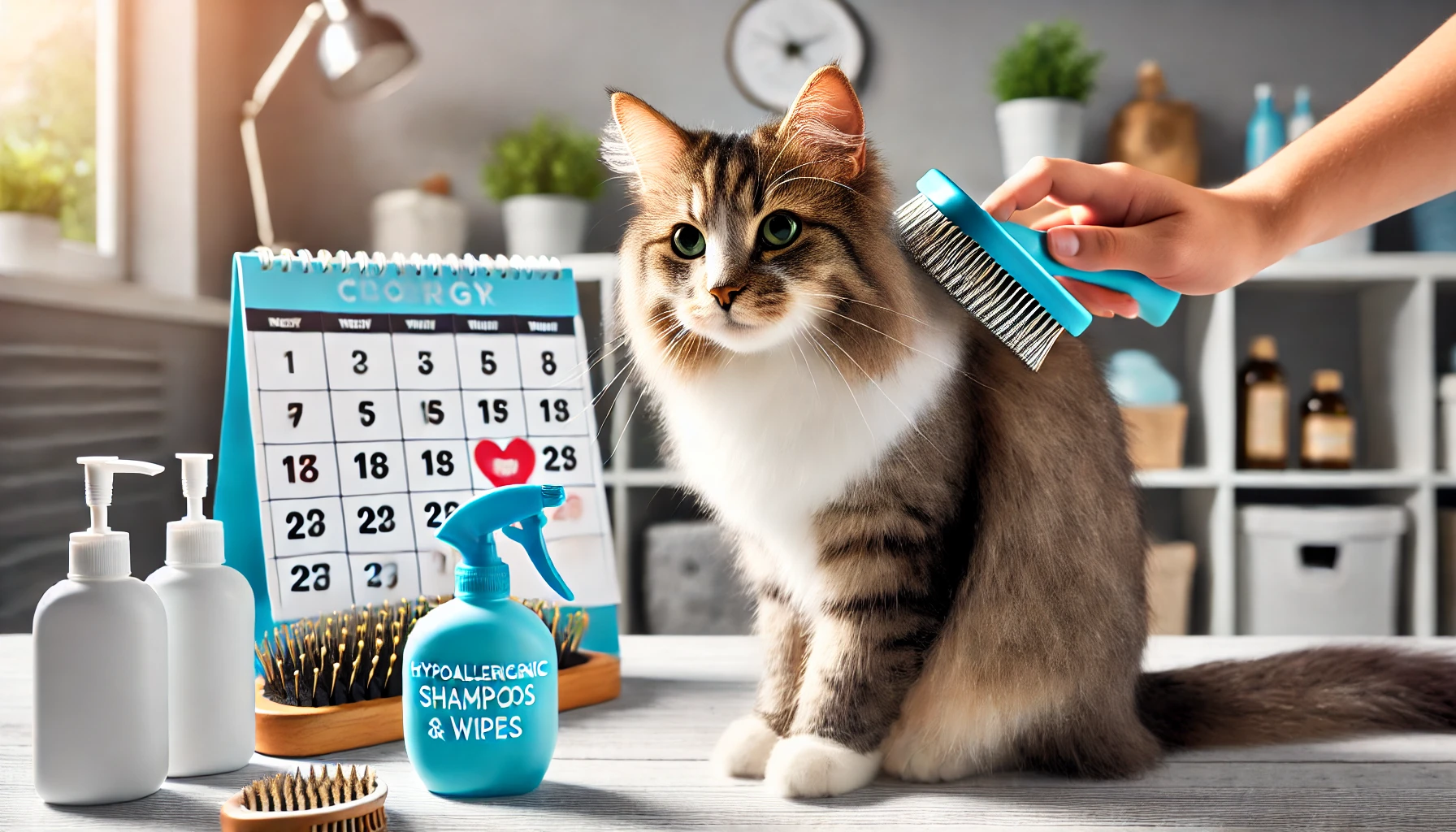
How Often Should You Groom an Allergy-Prone Cat?
The frequency of grooming is important in managing cat allergies.
Cats with allergic tendencies should be groomed more frequently than non-allergic or non-sensitive cats.
Here are some general guidelines for grooming:
- Brushing: 2-3 times a week to reduce dander and shedding.
- Bathing: Once a month to clean the skin and coat thoroughly.
- Wiping down: Daily, using non-toxic wipes or a damp cloth to reduce allergens on your cat’s coat.
Frequent grooming reduces the buildup of allergens, creating a cleaner and safer environment for both your cat and anyone with cat allergies in your household.
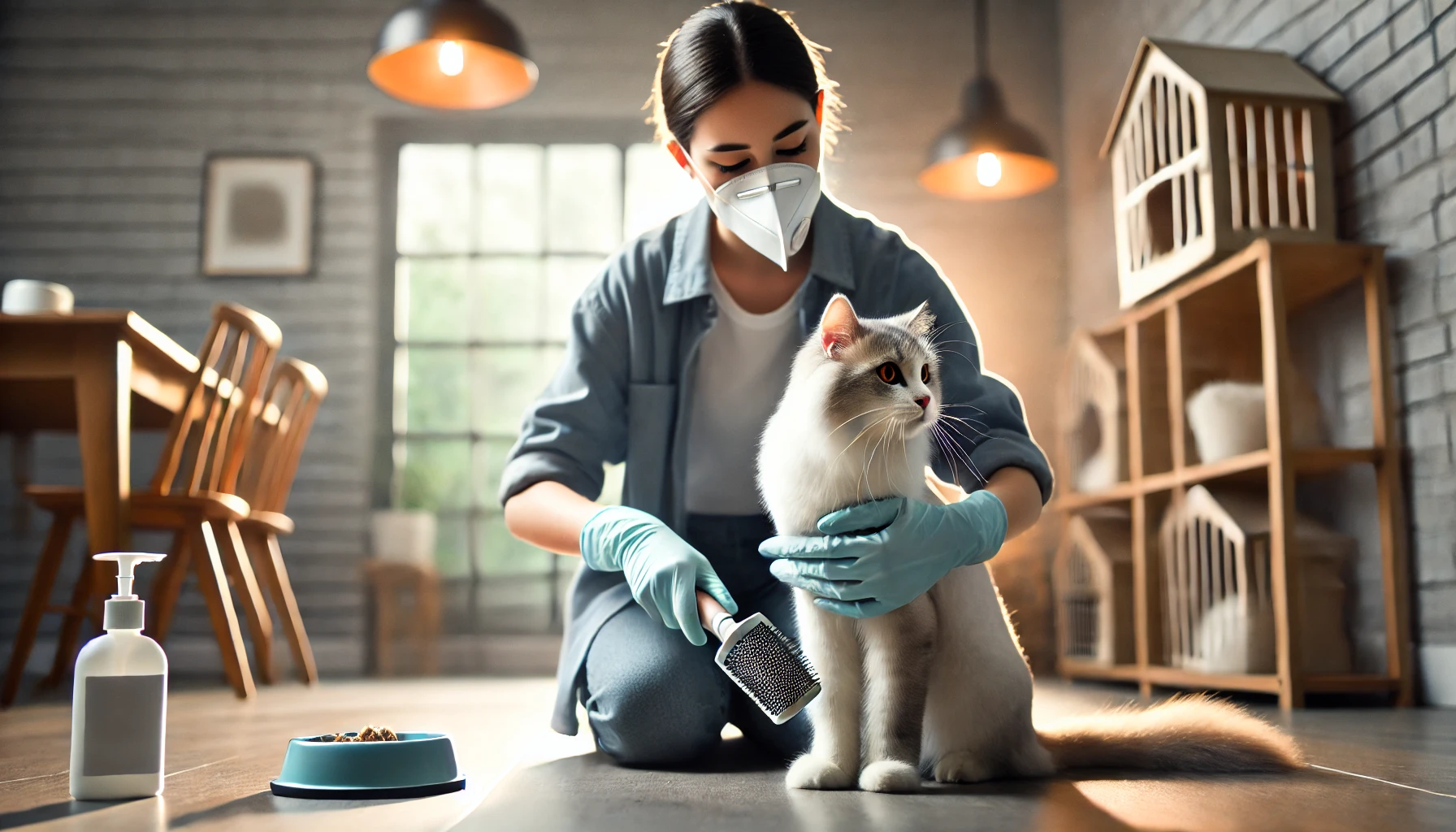
Safety Precautions for Owners
Grooming an allergy-prone cat can be challenging for owners who have cat allergies.
To minimize exposure to allergens during grooming, consider these protective measures:
- Wearing gloves: Always wear gloves while grooming your cat to reduce direct contact with allergens.
- Wearing a face mask: A face mask helps prevent inhaling airborne allergens such as dander during grooming or bathing.
- Grooming in a well-ventilated area: Choose a well-ventilated area to reduce the concentration of allergens in the air.
Following these safety measures will allow you to comfortably groom your cat while minimizing exposure to allergens.
Implementing the right grooming techniques, such as regular brushing and bathing, helps control dander and reduces allergic flare-ups in both cats and humans.
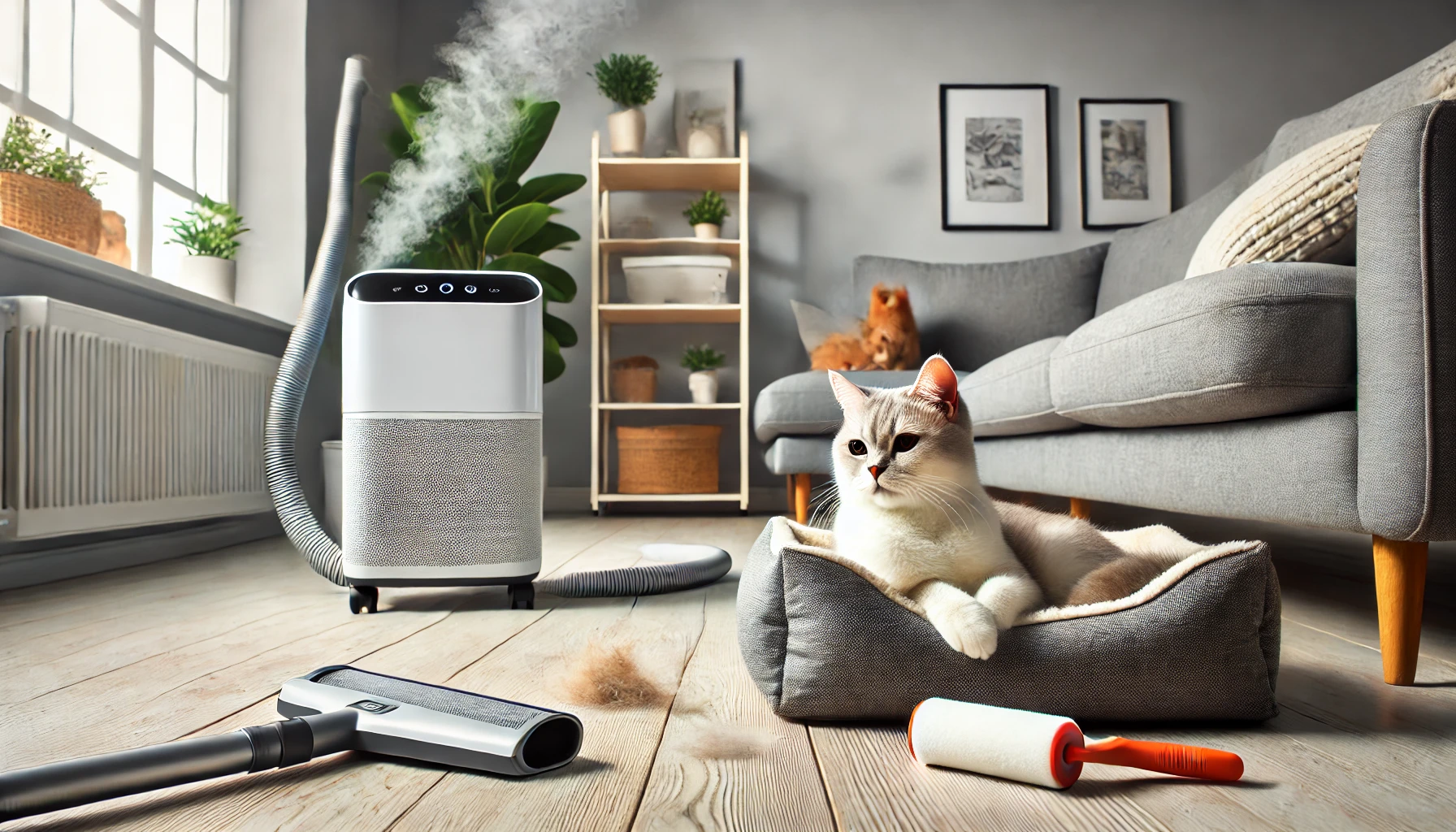
Preventive Measures to Cope with Cat Allergies at Home
Besides the use of hypoallergenic grooming products and regular grooming practices, managing cat allergies at home requires minimizing exposure to allergens.
You can easily achieve this with a few preventive measures that will significantly reduce cat allergens—like dander—in your home, making life more comfortable for both you and your cat.
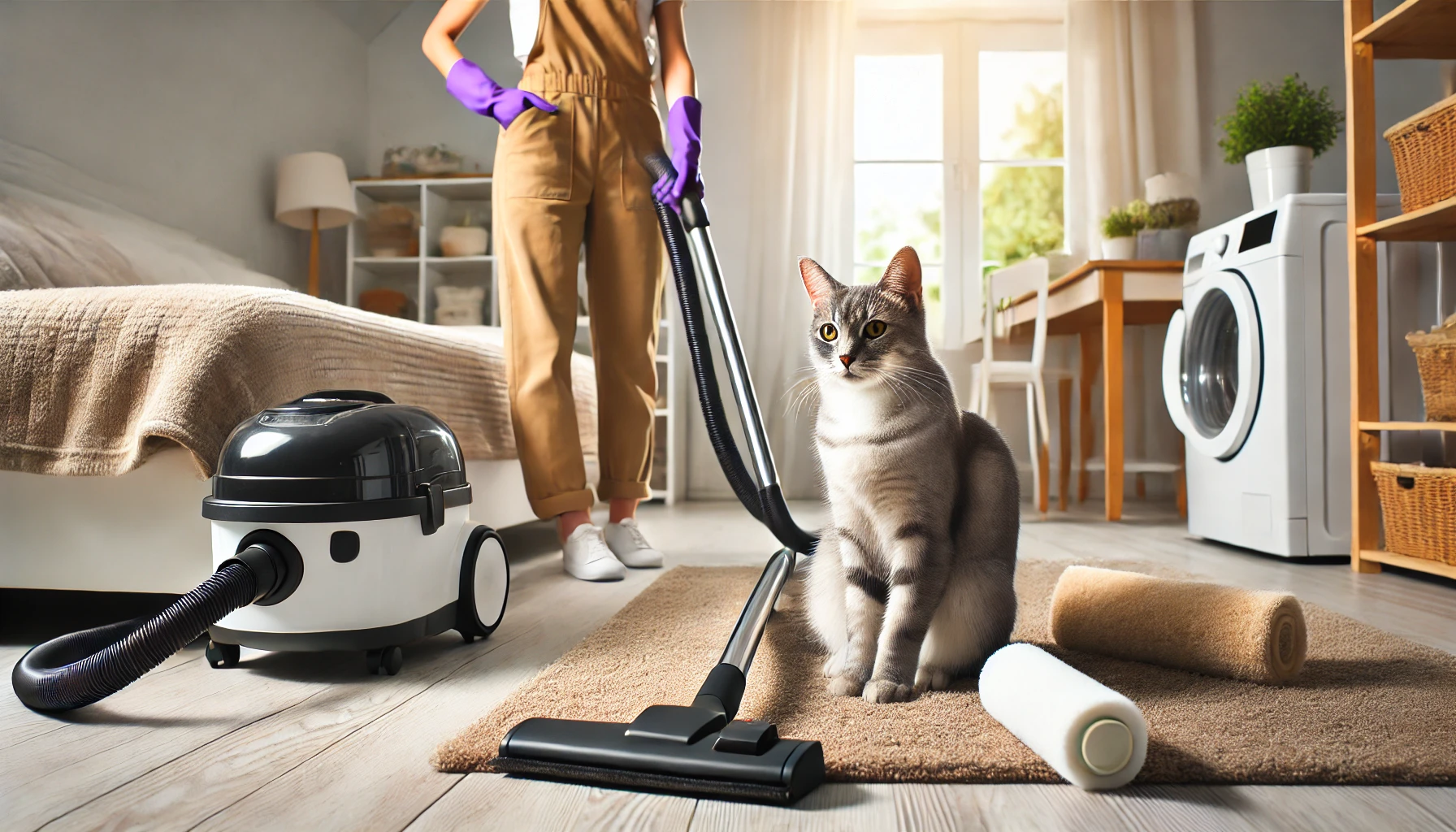
Keeping Your Cat’s Environment Clean
Keeping your home clean is crucial when managing cat allergies.
Allergens, such as dander, can stick to fabrics, carpets, and furniture, building up until they become problematic.
Regular cleaning will go a long way in reducing allergens.
Here are some tips to maintain a clean environment:
- Frequent vacuuming: Use a vacuum cleaner with a HEPA filter to effectively remove cat hair, dander, and other allergens from carpets, rugs, and upholstery.
- Wash bedding and blankets: Wash your cat’s bedding, blankets, and any fabrics your cat comes into contact with in hot water once a week to eliminate allergens.
- Wipe surfaces: Regularly clean hard surfaces such as floors, countertops, and windowsills to remove dander and fur.
- Use air purifiers: Place HEPA air purifiers in rooms where your cat spends the most time to filter out airborne allergens.
By incorporating these cleaning habits, you can reduce allergens in your home and create a safer environment for people with cat allergies.
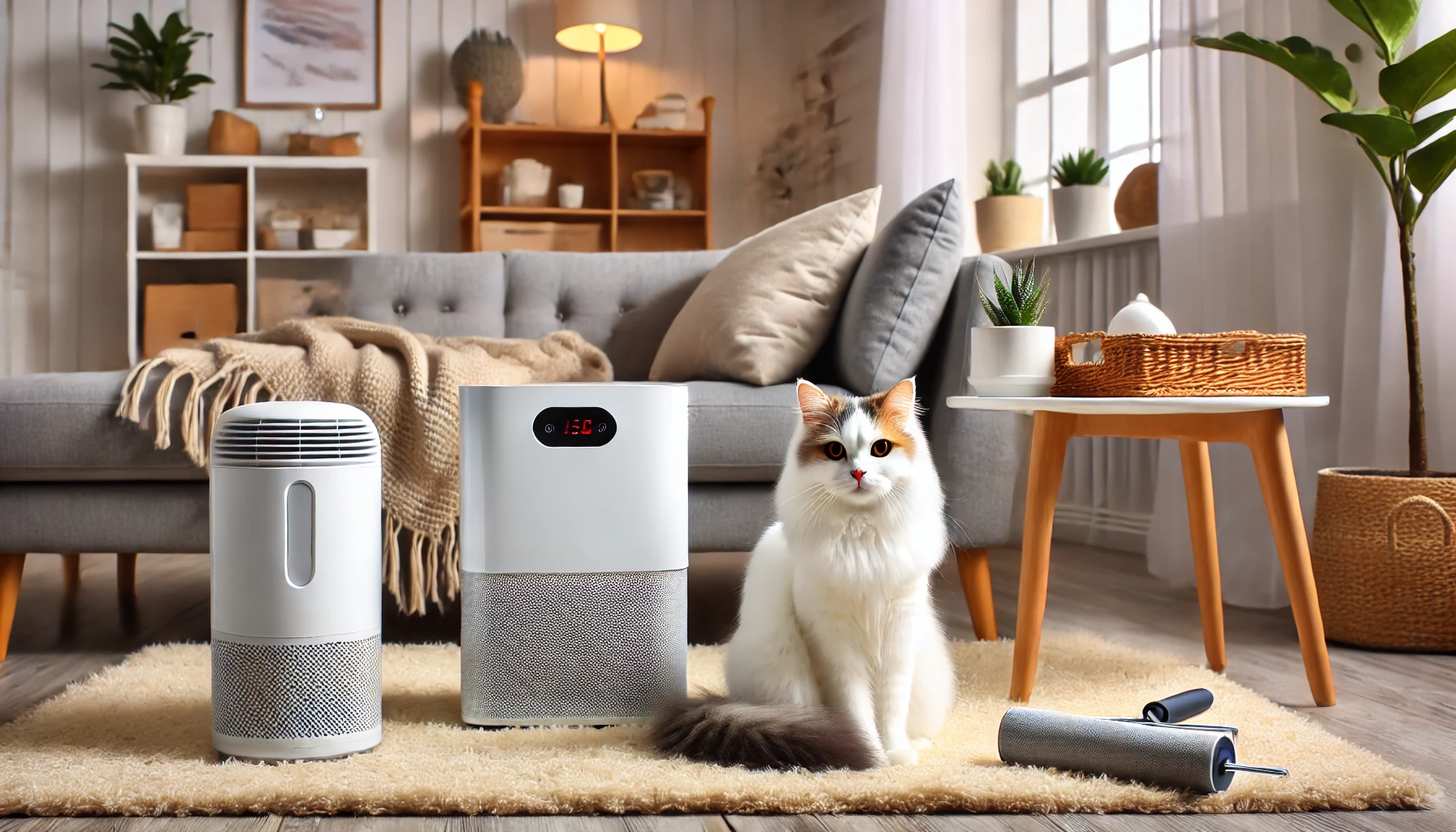
Air Purifiers and Other Tools for Allergy Prevention
Air purifiers and other tools can greatly help in reducing the spread of allergens.
HEPA air purifiers capture tiny airborne particles like dander, dust mites, and pollen, improving indoor air quality.
Here are some useful tools for preventing cat allergies:
- HEPA air purifiers: These purifiers are designed to capture microscopic allergens, making them essential for homes with cats.
- Humidifiers: Maintaining optimal humidity levels helps reduce airborne allergens. A humidifier prevents dry air, which can exacerbate allergic reactions.
- Lint rollers: Keep lint rollers handy to quickly remove cat hair and dander from clothes and furniture.
By combining these tools with regular cleaning practices, you can significantly reduce cat allergens and create a healthier home environment.
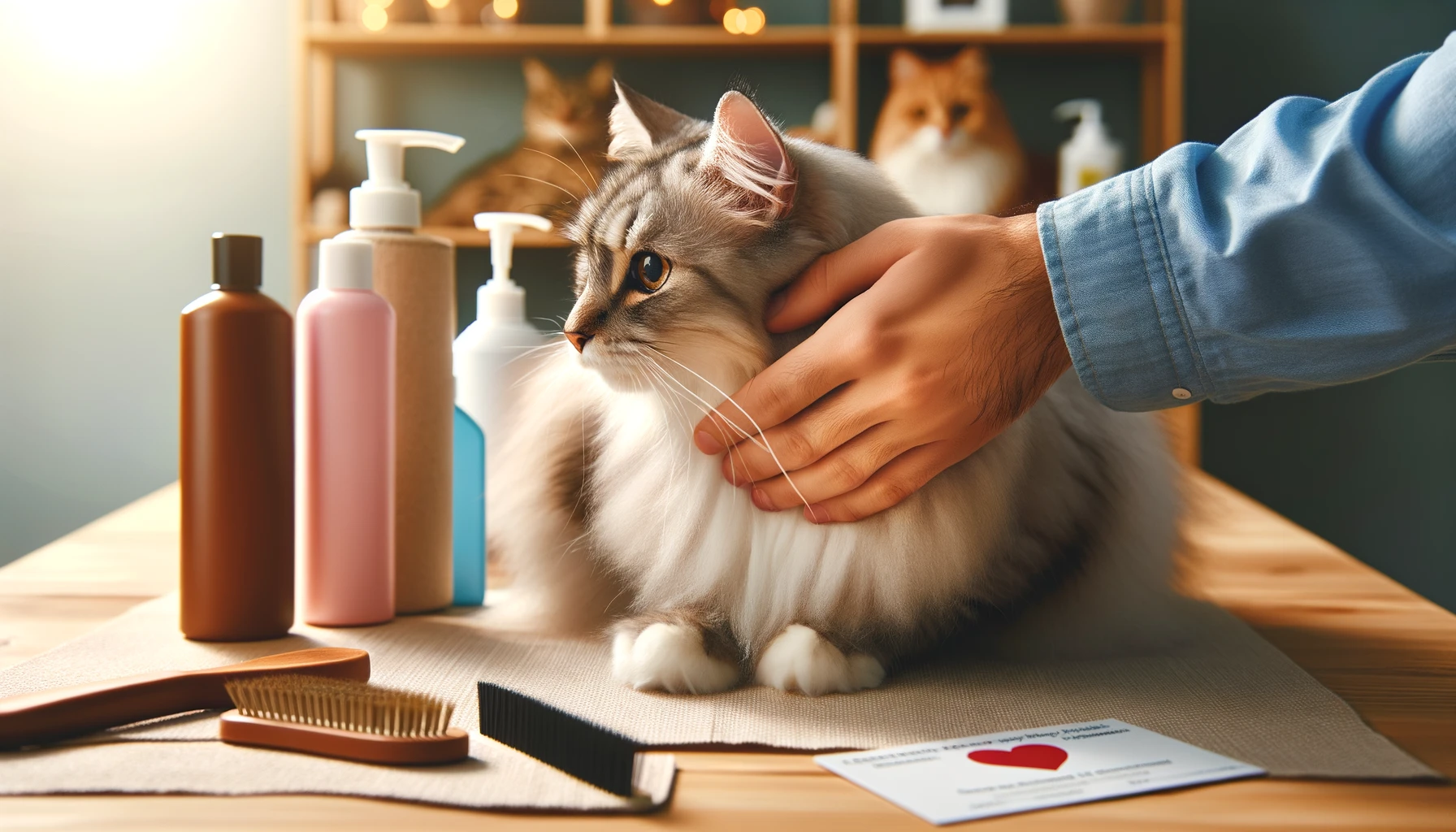
Monitoring Your Cat’s Health and Allergies
Monitoring your cat’s health is essential in managing cat allergies.
If your cat has sensitive skin or develops allergies, regular vet checkups and careful observation of symptoms are key.
Watch for the following signs:
- Frequent scratching or biting: If your cat is scratching or biting itself excessively, it could be a sign of an allergic reaction or skin irritation.
- Redness or skin irritation: Look for red patches or irritated skin, especially when introducing new grooming products or environmental changes.
- Excessive shedding or hair loss: If your cat is shedding excessively or has patchy hair loss, this could indicate allergies or skin problems.
If you notice any of these symptoms, consult with your veterinarian to identify the cause and administer appropriate treatments.
Being proactive about your cat’s health will help manage allergies for both your cat and your household.
Keeping your home clean, using HEPA air purifiers, and grooming your cat regularly are essential steps in minimizing allergens and creating a healthy environment.
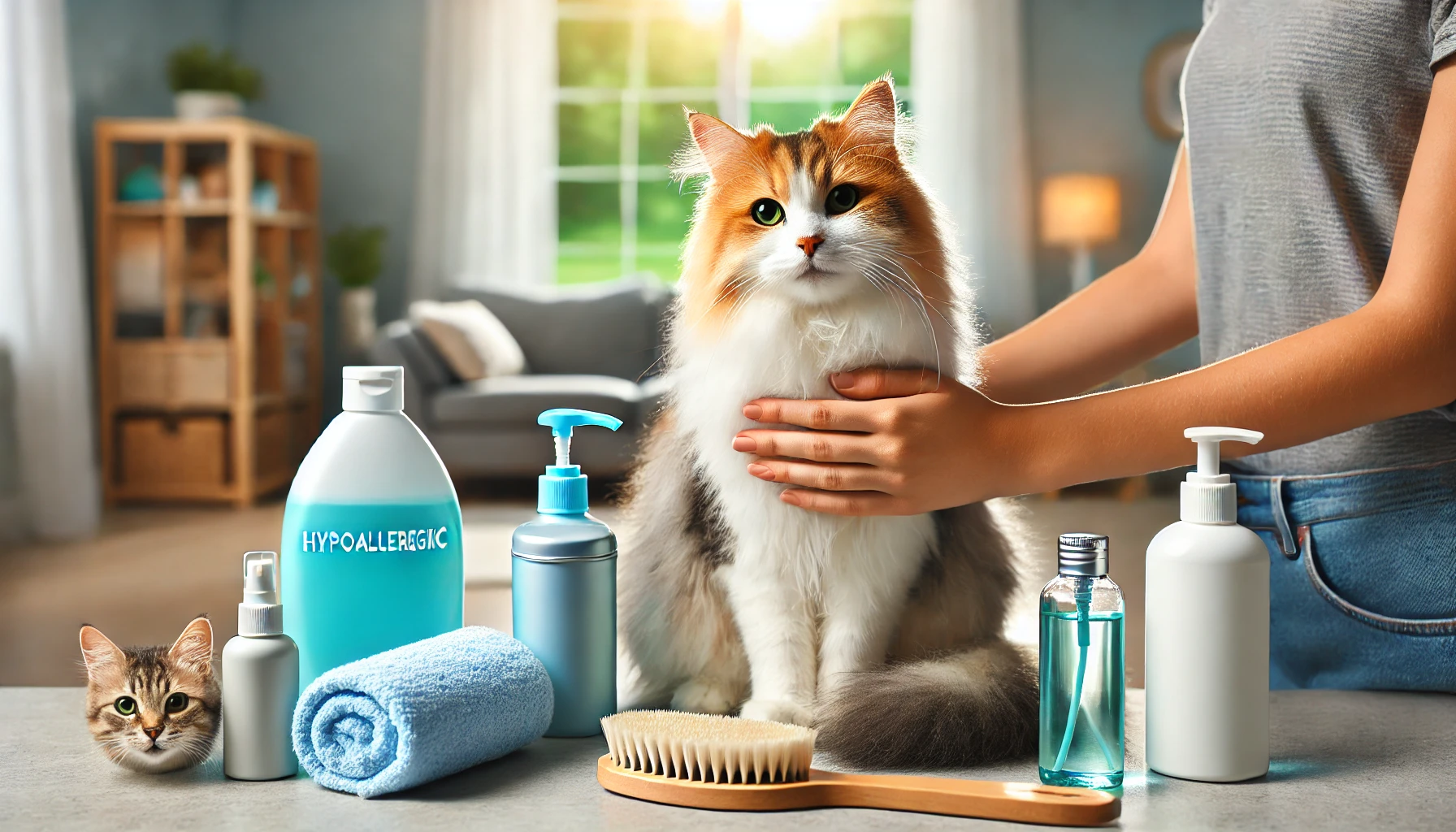
Conclusion: Safe Grooming to Control Cat Allergies
Cat allergies can be quite distressing for both cats and their owners, but with the right methods, managing them becomes achievable.
You can minimize cat allergies by understanding their causes and taking proper steps to reduce exposure to allergens for both your cat and everyone else in the household.
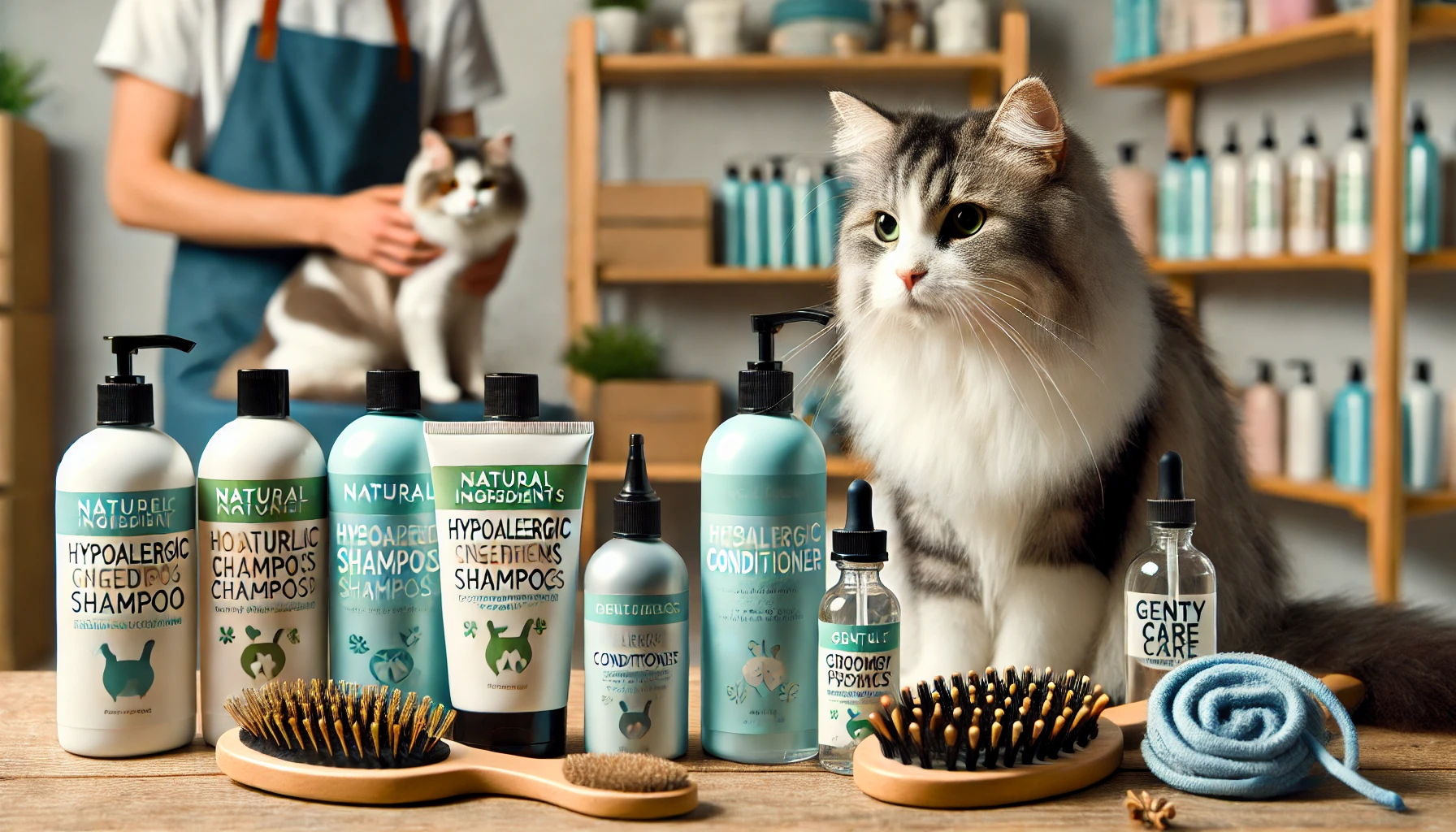
The Importance of Choosing the Right Grooming Products
An essential part of managing cat allergies is selecting safe, hypoallergenic grooming products.
Products that avoid harsh chemicals and allergens—such as sulfates, parabens, and artificial fragrances—are key to preventing allergic reactions.
Opt for grooming products with soothing ingredients like aloe vera, oatmeal, and coconut oil to promote healthier skin while reducing allergens.
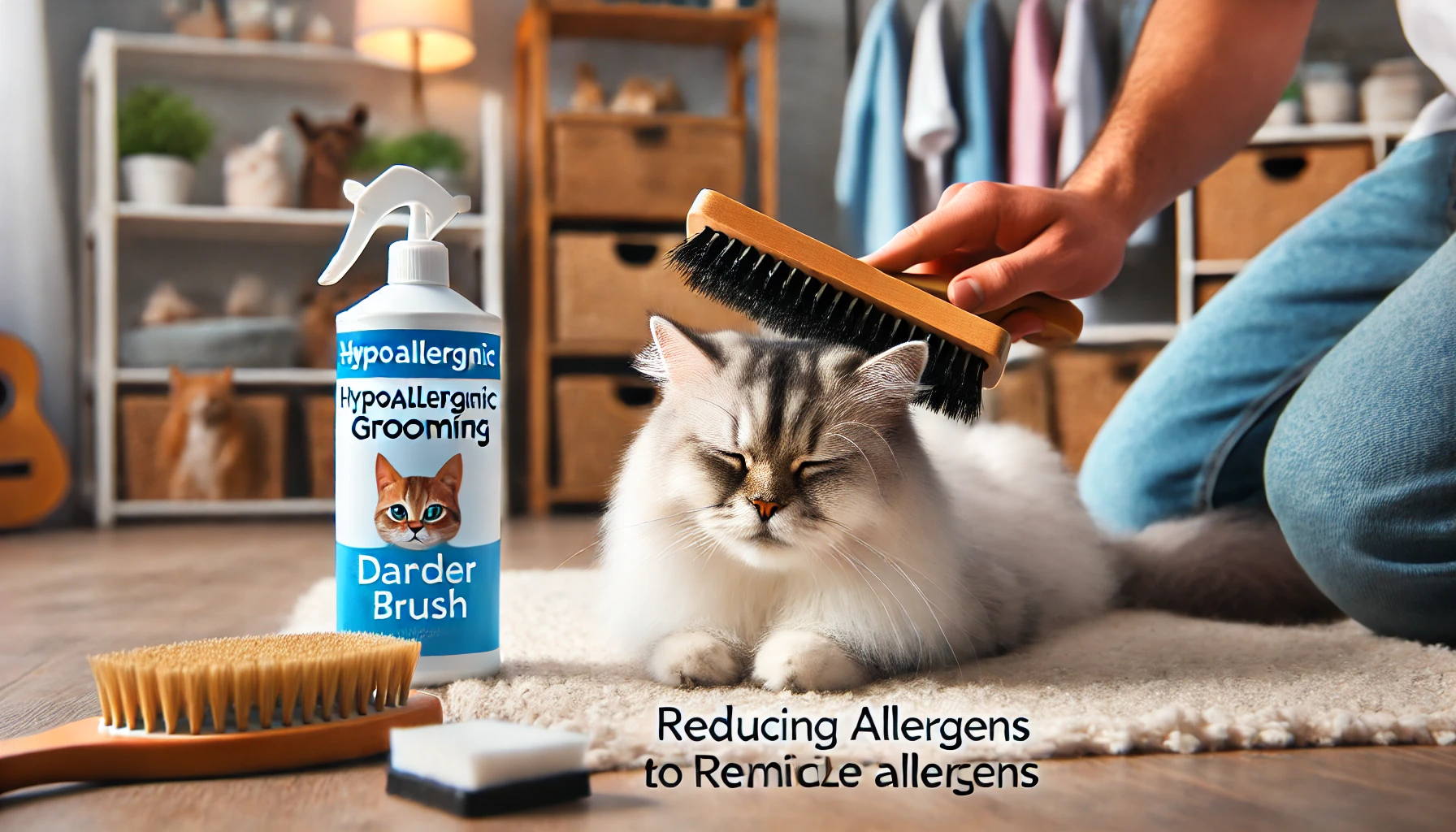
Regular Grooming to Reduce Allergens
Regular grooming is crucial in minimizing dander, which is a primary cause of cat allergies.
Techniques like frequent brushing, bathing with hypoallergenic shampoos, and wiping down your cat with a damp cloth can help reduce dander.
Regular grooming keeps your cat’s coat and skin healthy while decreasing the presence of allergens.
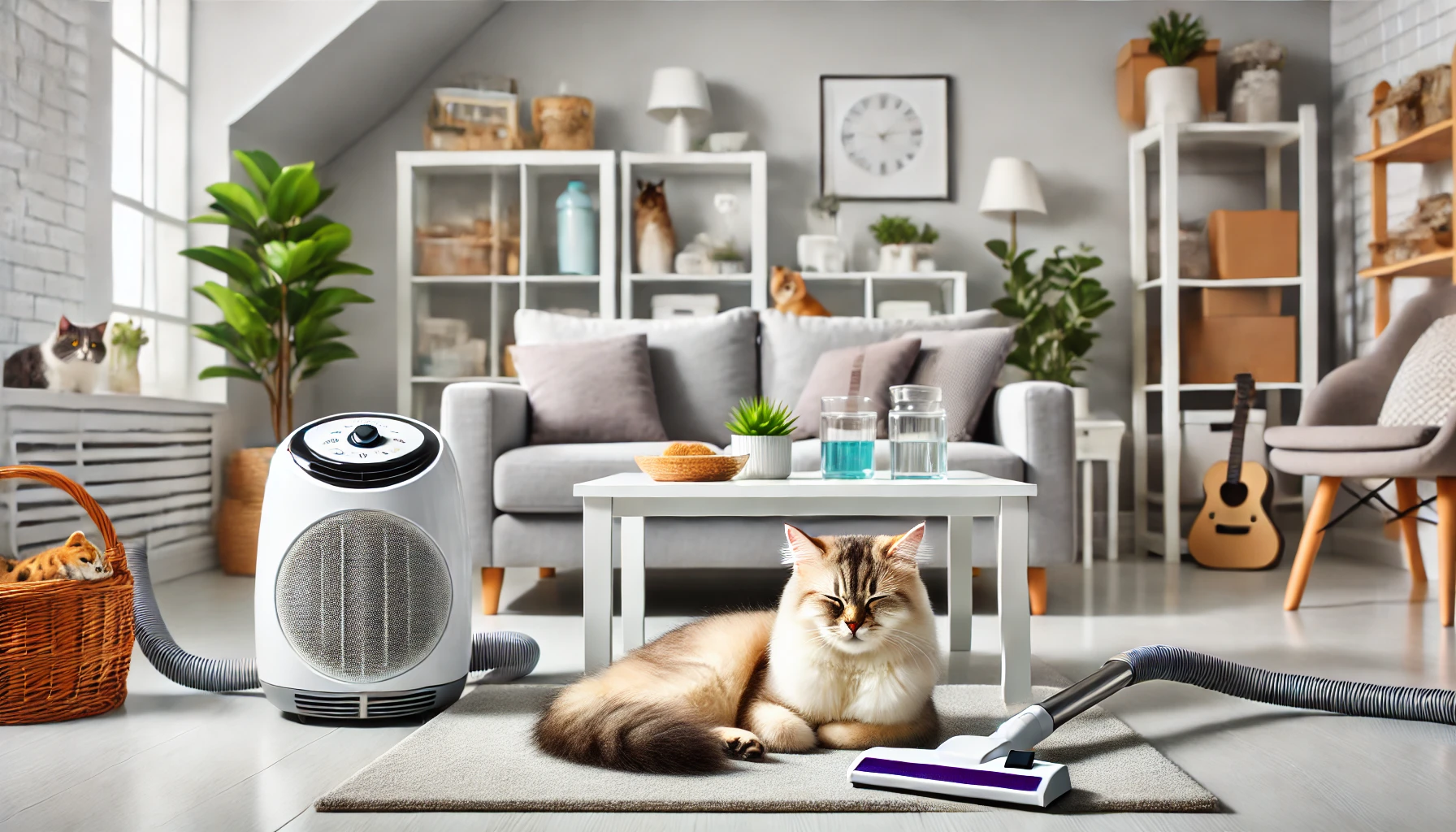
Maintaining a Clean and Allergy-Free Home
Maintaining a clean environment plays a significant role in reducing allergens.
Regular vacuuming with a HEPA filter, washing your cat’s bedding and blankets, and using air purifiers can help control the spread of dander and other allergens.
By adopting these habits, you create a more allergy-friendly space for both you and your cat.

Monitoring and Caring for Your Cat’s Health
Monitoring your cat’s health is vital in managing cat allergies.
If you notice your cat scratching excessively, showing redness, or shedding excessively, consult a vet.
Regular monitoring ensures your cat stays healthy and comfortable while reducing the likelihood of allergy flare-ups in the home.
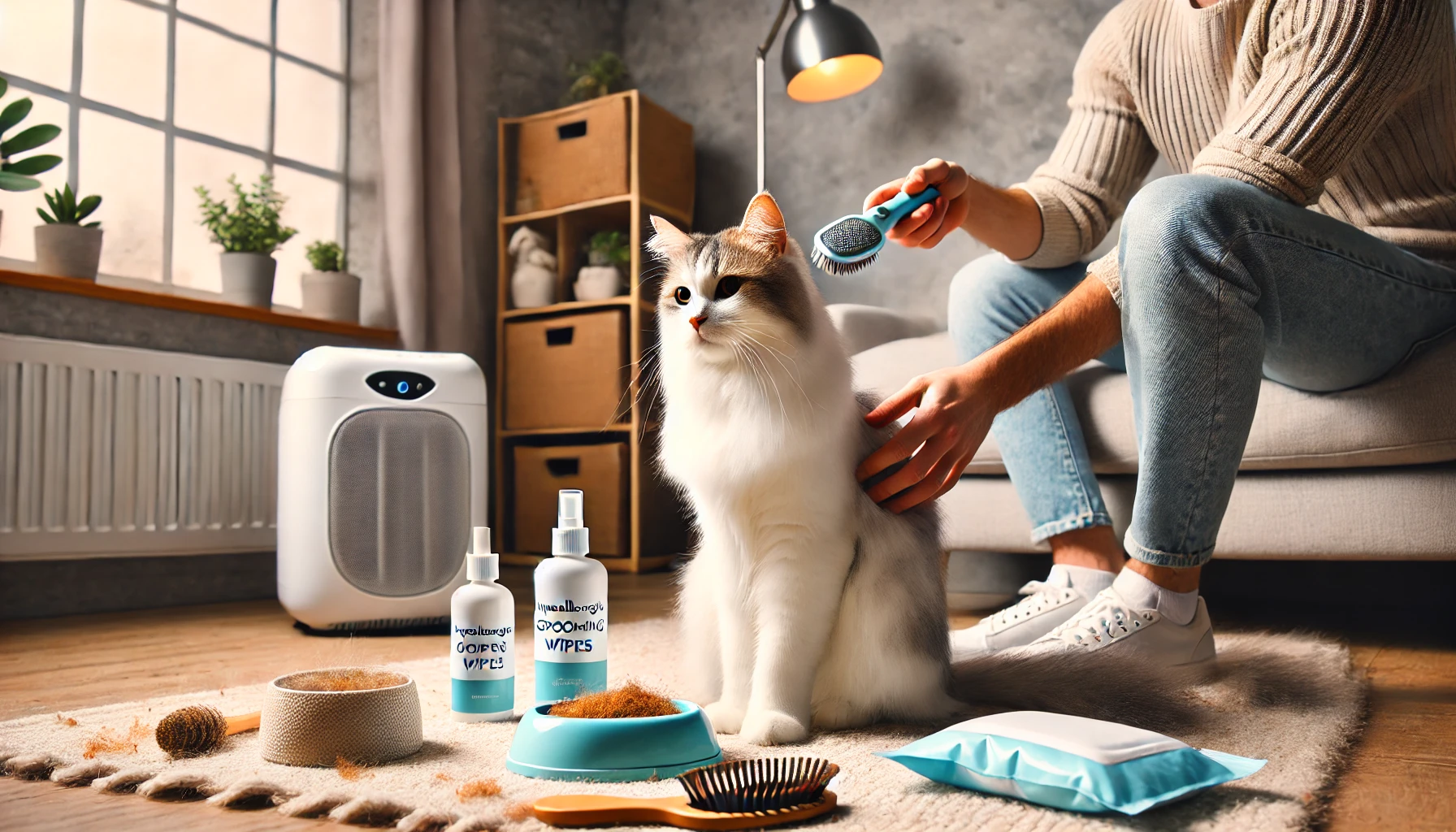
How to Effectively Prevent and Care for Allergy-Prone Cats
By applying appropriate grooming techniques, choosing the right products, and maintaining a clean home, you can significantly reduce the effects of cat allergies.
These strategies not only make your cat healthier but also improve the quality of life for anyone affected by cat allergens in your household.
Taking a proactive approach to managing cat allergies ensures a happier and healthier living environment for both you and your feline friend.
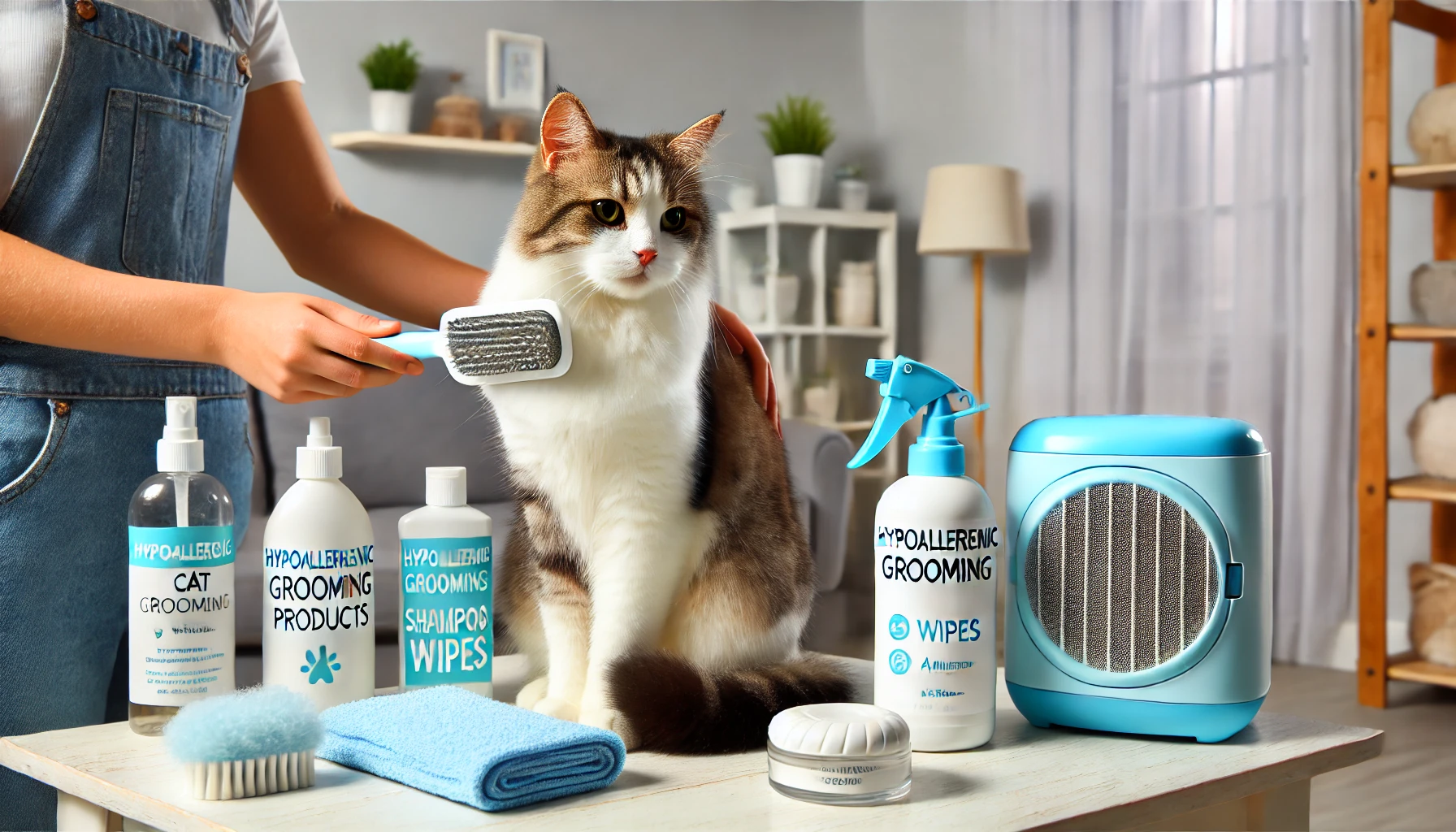
Cat Allergies and Safe Grooming: Frequently Asked Questions
Below are the most frequently asked questions about cat allergies and the best ways to safely groom your cat.
These answers will help clarify some misconceptions about managing cat allergies for both you and your feline friend.
What causes cat allergies?
The most common cause of cat allergies is dander, tiny pieces of dead skin that cats shed.
Other triggers include saliva, fur, and various proteins found in their skin and hair follicles.
How often should I groom my cat with allergies?
Groom your allergy-prone cat 2-3 times a week to reduce dander.
Monthly baths using hypoallergenic shampoo and daily wipes with a damp cloth will also help control allergens.
Do hypoallergenic grooming products help reduce cat allergies?
Yes, hypoallergenic grooming products are specifically formulated to avoid harsh chemicals and fragrances, reducing the amount of allergens such as dander, and making cat allergies easier to manage.
How can I minimize allergens in my house if I have a cat?
Vacuum regularly with a HEPA filter, wash your cat’s bedding frequently, and use air purifiers in rooms where your cat spends time.
These steps help reduce allergens like dander and cat hair.
Can an air purifier help with cat allergies?
Yes, HEPA air purifiers are highly effective at filtering out airborne allergens such as dander and fur, improving air quality and alleviating cat allergy symptoms.
What are the symptoms of allergies in cats?
Common symptoms of cat allergies include excessive scratching, biting, skin inflammation, and hair loss.
If you notice these signs, consult your vet for diagnosis and treatment options.
What grooming tools should I use on a cat with allergies?
Use soft-bristled brushes and non-toxic wipes to reduce irritation.
These tools help remove dander and minimize allergic reactions, making grooming more comfortable for both you and your cat.
Are there cat breeds that are less likely to cause allergies?
While no cat breed is completely hypoallergenic, breeds like the Sphynx, Balinese, and Siberian are known to produce fewer allergens.
However, reactions may vary among individuals with cat allergies.
How can I reduce cat dander?
Regular grooming, including brushing and bathing, helps reduce cat dander.
Wiping your cat with a damp cloth after grooming and using air purifiers also helps lower dander levels in your home.



